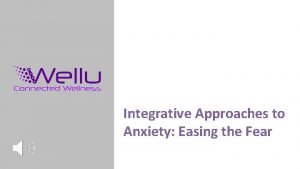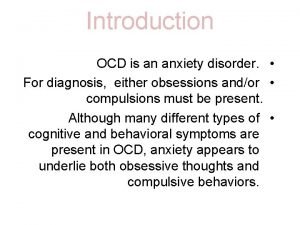Integrative Jungian Psychotherapy for Anxiety OCD Silvio Machado

- Slides: 1

Integrative Jungian Psychotherapy for Anxiety & OCD Silvio Machado, Ph. D. ~ Assistant Professor ~ Department of Counseling Sonoma State University Background Central Concepts It is estimated that anxiety disorders may affect over 33% of the population at any given time 1. Obsessive-compulsive disorder (OCD) is estimated to affect approximately 1. 2% of the population 2, 3. Cognitivebehavioral interventions for anxiety and OCD have received a great deal of attention for their efficacy and growing evidence base, yet these approaches, which focus on symptom elimination, miss important symbolic aspects of the client’s experience of the disorder that have the potential for meaning, insight into the client’s inner life, and the resolution of traumatic history. Jungian Concepts Symbolic Attitude – When the clinician listens to the content of the client’s account of problems/symptoms with an appreciation for the objective occurrences these are and a curiosity about the meaning in the psyche these occurrences carry. Jungian analytical psychotherapy, like many other psychodynamic approaches, is concerned both with meaning in the client’s life and the process by which the client becomes more themselves by integrating fragmented, wounded, and hidden aspects of the psyche. This theoretical paper brings together Jungian concepts and trauma theory to generate an integrative framework for psychotherapy with individuals with anxiety and OCD. Drawing on the symbolic attitude and Jung’s complex theory, along with contemporary thought on dissociation and multiplicity, mindfulness, and trauma processing, the author asserts that, in some cases, symptoms of anxiety and OCD are the expressed manifestation of unprocessed trauma bound within the psyche. Complex – “Complexes are psychic fragments which have split off owing to traumatic influences…complexes interfere with the will and disturb conscious performance…complexes are independent 4 beings [in the psyche]. ” Complexes must be discharged to heal them. Trauma Therapy Concepts Dissociation & Multiplicity – There is a long history in the psychological literature that emphasizes multiplicity—the psyche’s capacity to subdivide into parts with their own subjective perspectives 5, 6, 7. This division is especially common among trauma survivors. Mindfulness – Mindfulness supports the ability to witness anxious and obsessive thoughts, feelings, sensations, perceptions, 8 and impulses, while acting intentionally. Trauma Processing – Approaches such as eye movement desensitization and reprocessing (EMDR)9 support the processing of faultily stored trauma memories. By discharging the overwhelming elements of these memories, the memories become less disturbing and less likely to be triggered. Theoretical Integration Between 30 -82% of trauma survivors meet the diagnostic criteria for OCD 10. Jung’s complex theory aligns with current trauma theory, which emphasizes working with the ”younger parts” of the psych that hold the unresolved trauma memories. Taking a symbolic attitude, symptoms of anxiety and OCD are understood as the manifestation of trauma-related complexes, or parts, as they disturb consciousness. Anxiety usually involves the complex’s ongoing anticipation of threat, while obsessions and compulsions usually represent the complex’s attempts to prevent danger associated with that anticipated threat. Mindfulness plays a key role when working with complexes, as it allows the client to adopt an observing stance toward the anxiety, obsessive thoughts, and compulsive behavior driven by the complex. Trauma processing from a Jungian perspective involves helping the client to develop a conscious relationship to the complex, using mindfulness, so that its central memories may be drawn out and targeted for reprocessing. Once reprocessed, these memories and their dissociated affect are less likely to be triggered and overtake consciousness. References 1. Bandelow, B. , & Michaelis, S. (2015). Epidemiology of anxiety disorders in the 21 st century. Dialogues in Clinical Neuroscience, 17(3), 327– 335. 2. American Psychiatric Association. (2013). Diagnostic and statistical manual of mental disorders (5 th ed. ). Washington, DC: Author. 3. Ruscio, A. M. , Stein, D. J. , Chiu, W. T. , & Kessler, R. C. (2010). The epidemiology of obsessive-compulsive disorder in the national comorbidity survey replication. Molecular Psychiatry, 15(1), 53– 63. http: //doi. org/10. 1038/mp. 2008. 94 4. Jung, C. G. (1969). A review of complex theory (R. F. C. Hull, Trans. ). In Read, H. , Fordham, M. , Adler, G. , & Mc. Guire, W. (Eds. ), The collected works of C. G. Jung (Vol 8, pp. 92 -104). Princeton, NJ: Princeton University Press. (Original work published 1948) 5. Siegal, D. (1999). The developing mind: Toward a neurobiology of interpersonal experience. New York, NY: Guilford Press 6. Bromberg, P. (1996). Standing in the spaces: The mulitiplicity of self and the psychoanalytic relationship. In P. Bromberg (Ed. ), Standing in the spaces: Essays on clinical process, trauma, and dissociation (pp. 267 -290). Hillsdale, NJ: The Analytic Press. 7. Van der Hart, O. , Nijenhuis, E. R. S. , & Steele, K. (2006). The haunted self: Structural dissociation and the treatment of chronic traumatization. New York, NY: Norton. 8. Baer, R. A. , Smith, G. T. , Hopkins, J. , Krietemeyer, J. , & Toney, L. (2006). Using self-report assessment methods to explore facets of mindfulness. Assessment, 13, 27 -45. doi: 10. 1177/1073191105283504 9. Shapiro, F. (2001). Eye movement desensitization and reprocessing (EMDR): Basic principles, protocols, and procedures (2 nd ed. ). New York, NY: Guilford Press. 10. Cromer, K. R. , Schmidt, N. B. , & Murphy, D. L. (2006). An investigation of traumatic life events and obsessive-compulsive disorder. Behaviour Research and Therapy, 45, 1683 -1691. doi: 10. 1016/j. brat. 2006. 08. 018

